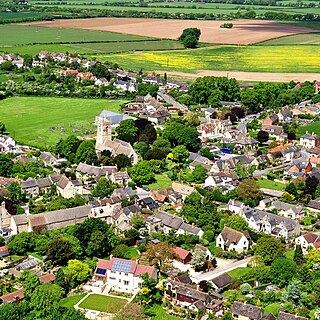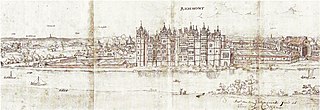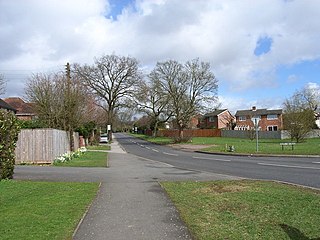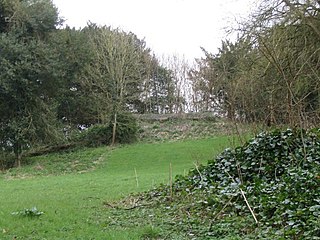Related Research Articles

Oxfordshire is a ceremonial county in South East England. The county is bordered by Northamptonshire and Warwickshire to the north, Buckinghamshire to the east, Berkshire to the south, and Wiltshire and Gloucestershire to the west. The city of Oxford is the largest settlement and county town.

Woodstock Palace was a royal residence in the English town of Woodstock, Oxfordshire.

St Leonards is a small village in the Chiltern Hills in Buckinghamshire, England. It is 3 miles east of Wendover and 4 miles south of Tring, Hertfordshire. A short section of Grim's Ditch delineates the northern end of the village, which lies within the civil parish of Cholesbury-cum-St Leonards.

Asheridge is a small hamlet in the parish of Chartridge, in Buckinghamshire, England. Prior to 1898 it was part of Chesham parish. It is situated in the Chiltern Hills, about two and a half miles north west of Chesham, 5 miles from Great Missenden and 6 miles from Wendover.

Brill is a village and civil parish in west Buckinghamshire, England, close to the border with Oxfordshire. It is about 4 miles (6 km) north-west of Long Crendon and 7 miles (11 km) south-east of Bicester. At the 2011 Census, the population of the civil parish was 1,141. Brill has a royal charter to hold a weekly market, but has not done so for many years.

Little Missenden is a village and civil parish on the River Misbourne in Buckinghamshire, England. It is in the Chiltern Hills, about 3 miles (5 km) southeast of Great Missenden and 3 miles (5 km) west of Amersham. The village lies on the River Misbourne in the Misbourne valley.

Pednor is a hamlet in the parish of Chartridge, in Buckinghamshire, England. It is located in the Chiltern Hills two miles northwest of Chesham and seven miles southeast of Wendover.

Aylesbury is a constituency represented in the House of Commons of the UK Parliament since 2019 by Rob Butler of the Conservative Party.
Sopwell Priory was a Benedictine nunnery founded around 1140 on the site of an ancient hermitage in Sopwell, Hertfordshire, England. After the Dissolution, the priory was torn down and a Tudor manor house constructed in its place.
The Abbey of Arrouaise in northern France was the centre of a form of the canonical life known as the Arrouaisian Order, which was popular among the founders of canonries during the decade of the 1130s. The community began to develop when Heldemar joined the hermit Ruggerius in 1090 and approved by the local bishop in 1097. The priory was raised to the status of an abbey in 1121, electing as its first abbot, Gervaise. He impressed people who had the wealth and secular power, sufficient to found an abbey, which they did.

Richmond Palace was a royal residence on the River Thames in England which stood in the sixteenth and seventeenth centuries. Situated in what was then rural Surrey, it lay upstream and on the opposite bank from the Palace of Westminster, which was located nine miles (14 km) to the north-east. It was erected in about 1501 by Henry VII of England, formerly known as the Earl of Richmond, in honour of which the manor of Sheen had recently been renamed "Richmond". Richmond Palace therefore replaced Shene Palace, the latter palace being itself built on the site of an earlier manor house which had been appropriated by Edward I in 1299 and which was subsequently used by his next three direct descendants before it fell into disrepair.

Bermondsey Abbey was an English Benedictine monastery. Most widely known as being founded in the 11th century, it had a precursor mentioned in the early eighth century, and was centred on what is now Bermondsey Square, the site of Bermondsey Market, Bermondsey, in the London Borough of Southwark, southeast London, England.

Missenden Abbey is a former Arrouasian (Augustinian) monastery, founded in 1133 in Great Missenden, Buckinghamshire, United Kingdom. The abbey was dissolved in 1538, and the abbey church demolished. In 1574 a house, also known as Missenden Abbey, was constructed on the site of the monastic cloisters, incorporating some of the monastic remains. The house was altered several times, gaining its current "Regency Gothic" style at the beginning of the 19th century. The house was "gutted" by fire in 1985 and subsequently rebuilt.


The remains of Ashley Castle are in the small village of Ashley, Test Valley, in Hampshire. The visible remains now consist of sections of the ditch and ramparts.

Burnham Abbey was a house of Augustinian canonesses regular near Burnham in Buckinghamshire, England. It was founded in 1266 by Richard, 1st Earl of Cornwall. The abbey of St Mary consisted of around twenty nuns at the outset, but was never wealthy and by the time of its dissolution in 1539 there were only ten.
Buckinghamshire Archives is the county record office for Buckinghamshire, England. It houses the former Buckinghamshire Record Office and the former Buckinghamshire Local Studies Library. It is located in the offices of Buckinghamshire Council, in Walton Street, Aylesbury.
Grovebury Priory, also known as La Grave or Grava was a priory in Leighton Buzzard, Bedfordshire, England. It was established in 1164 and disestablished in 1414.
The Grange was a country house and estate at the village of Chalfont St Peter in Buckinghamshire, England, in the United Kingdom.
References
- 1 2 Lysons, Samuel (1806). Magna Britannia: Being a Concise Topographical Account of the Several Counties of Great Britain. Containing Bedfordshire, Berkshire, and Buckinghamshire. Vol. 1. Cadell. pp. 522–523. Retrieved 3 April 2017.
- ↑ Kaye, Elaine (1973). A History of Missenden Abbey. Missenden Abbey Adult Education College. p. 9. Retrieved 3 April 2017.
- ↑ Yates, Edmund Hodgson (1885). Time: A Monthly Magazine of Current Topics, Literature & Art. Swan Sonnenschein & Co. p. 465. Retrieved 3 April 2017.
- ↑ Historic England. "Earthworks near Brill Church (1006925)". National Heritage List for England . Retrieved 8 October 2016.
